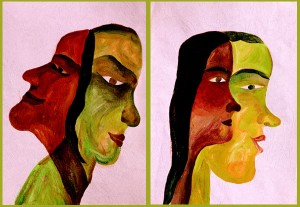Communication styles: when our defense mechanisms lead us into trouble and strife. What style are you and how assertive can you be?
Our style of communication develops at an early age when we adopt defense mechanisms that we feel protect us from harm and punishment. This learning reflects our personality, self-esteem and it is adopted from our environment.
In our adulthood these styles become instinctive defense mechanisms, conscious or unconscious modus operandi, and they rarely work…
Let’s have a quick look at each:
PASSIVE:
Passive individuals tend to:
- Speak softly and not maintain eye contact
- Bite their lip and stew on their emotions until the point of explosion (which is often disproportionate to the situation)
- Feel guilt and shame afterwards and revert to staying quiet
- Feel powerless and victimized
- Experience resentment, depression and confusion
- Boundaries are loose and self-esteem is low
AGGRESSIVE:
Individuals with this style tend to:
- Express feelings, needs and opinions that disregard the rights of others
- Can be verbally or physically abusive; rude, loud, demanding and threatening
- Criticize, humiliate or blame through ‘you’ statements rather than take responsibility
- Have low frustration tolerance
- Feel alienated from others and foster fear and hatred in others
- Boundaries are rigid and self-esteem is low
PASSIVE-AGGRESSIVE:
As the name suggests, the passive-aggressive person has elements of both.
This means that individuals tend to:
- Appear easy going when anger is brewing below the surface
- Mutter to themselves rather than confront the person
- Smile when angry or resentful and deny there is a problem
- Use mockery, and sarcasm in an attempt to defend and get even
- Disrupt or subtly sabotage a situation they don’t like
- Feel overwhelmed by powerlessness, alienated from others and stuck
- Boundaries are loose and self-esteem is low
CONVERGENCE
In the real world, we all have a propensity to one or other style. However, none of the three is any better or worse than its counterparts.
Indeed, one’s tendency does not mean that the others will not be engaged in at one time or another. For example, the passive can become aggressive, just as the aggressive person who seeks to not flare up, can err on the passive side. The passive-aggressive, already embraces both.
Personally, when I lose my centre and my self-esteem is low, I tend towards the passive-aggressive behaviour. Thankfully I either recognize it or my loved ones point it out!
COMMUNICATING WITH THE SHADOW
Recognizing and accepting our style, allows us to embrace our shadow side.
If we find ourselves in pattern, it means that we’re experiencing our needs as:
- Unheard
- Challenged or
- Under threat
Engaging in inner dialogue can help us move away from stuckness, resentment and lashing out. By listening, without judgment to the part that is in pain and afraid, can help identify any assumptions that may be clouding our perspective and centre us.
While this part may want to lash out unconstructively, it also has the gift of sensitivity. Therefore, giving it a task that can channel this ability can turn it into a great ally.
For instance, I might say, “I value what you have to say; tell me what you are feeling so that we can find a different way of expressing it.”
Such inner dialogue can prepare the ground for true assertive communication.
WHAT DOES ASSERTIVE TRULY MEAN?
It means standing up for one’s rights without violating others.
Assertive behaviour has high self-esteem at its basis. In other words:
- Respect
- Equality and
- Self-worth
As such, assertive people tend to:
- Speak calmly, in a clear and respectful manner and have a relaxed body posture, without needing to prove anything
- Use ‘I’ statements and express feelings clearly and appropriately
- Handle criticism without tears and tantrums
- Take responsibility for their actions without blaming others
- Neither dominate others or involve themselves in put-downs
- Are prepared to take the consequences of expressing feelings and wants
WHAT ASSERTIVENESS IS NOT
Being assertive is sometimes mistaken for being aggressive – talking down to people or making demands.
For example, “ I clearly asked for my steak to be rare, not well done! I refuse to eat this. I want what I asked for!” is not assertive. Indeed, chances are the waiting staff will tell the kitchen to mop the floor with the steak before they cook it!
The assertive person might say, in a calm and polite manner: “Excuse me, I asked for a rare steak and this is well-done, would you mind doing it again please?”
Being sarcastic at the end of the meal is also not assertive!
CONCLUSION
Wouldn’t it be great if we could all wake up one day and be naturally assertive and never resort to our knee-jerk reactions and defense mechanisms? Alas, this is a dream that may not come true.
Accepting our idiosyncrasies however, means that we can learn a new language and allow our ‘shadow’ styles to inform us of our feelings and our assumptions.
This means being aware. By:
- Noticing what’s happening
- Engaging in inner dialogue and asking why
- Discerning between assumptions, perceptions and reality
- Using an assertive communication style
Courage forms part and parcel of being assertive; be it the courage to be softer or stronger. Assertive people feel the fear of conflict and do it anyway – because they know they need to start somewhere and face the consequences of speaking up.
Being assertive has true strength on its side. The other styles can be underhanded or ‘overhanded’, spiteful and rarely successful.
An analogy that best depicts how these play out, is the relationship between the Coyote and the Road Runner – and we all know what happens there . . . !





